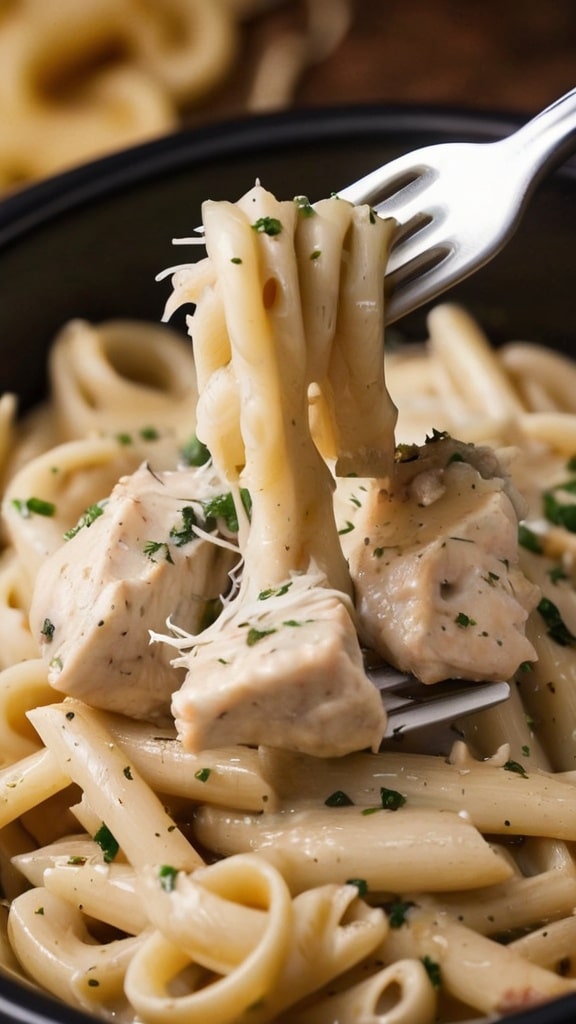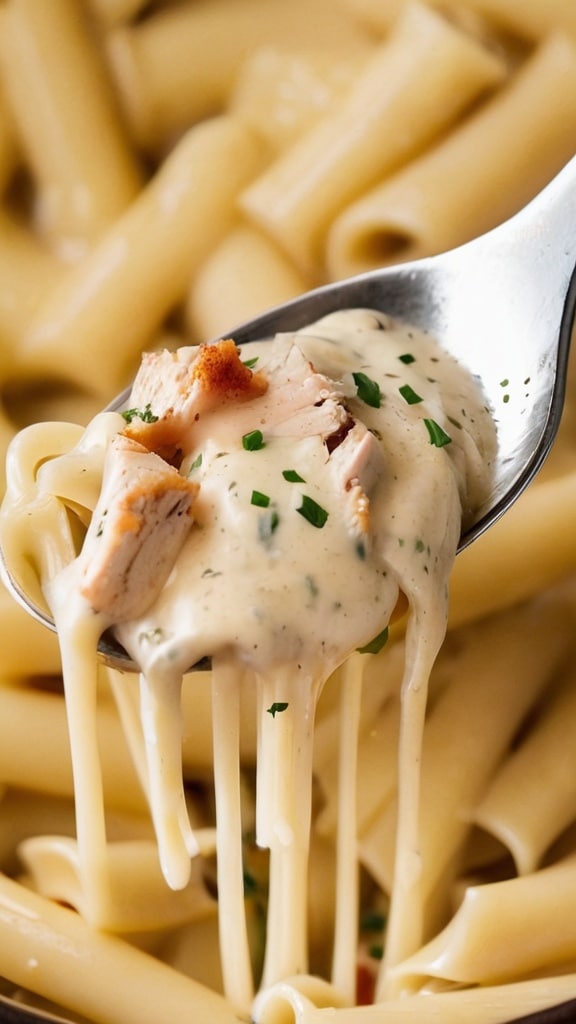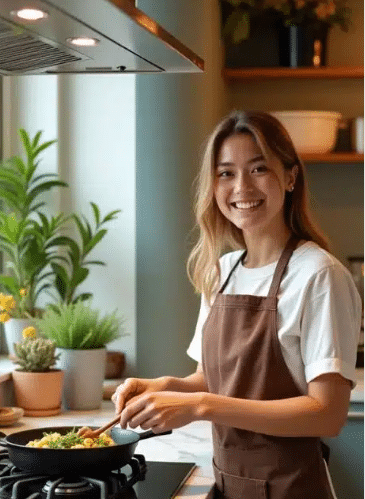I’ll never forget the night my Italian grandmother watched me prepare her sacred chicken pasta recipe in a slow cooker. Her expression shifted from horror to curiosity to reluctant approval as the aromas of garlic, herbs, and parmesan filled the kitchen. “Maybe there’s something to this lazy cooking afterall,” she murmured, taking her first bite of the creamiest, most flavor-packed pasta that required almost no effort. That moment changed everything I thought I knew about traditional Italian cooking versus modern convenience.
Crock Pot Garlic Parmesan Chicken Pasta is a revelatory one-pot wonder that combines tender chunks of chicken, al dente pasta, and a velvety, garlicky parmesan sauce all cooked effortlessly in your slow cooker. What makes this dish special isn’t just its convenience (though waking up to dinner practically ready is pretty magical), but how the slow, gentle heat infuses every ingredient with remarkable depth of flavor.
Unlike stovetop versions where flavors remain somewhat separate, this method creates a harmonious marriage of ingredients where the chicken contributes richness to the sauce, the pasta absorbs the savory essence of the broth, and the parmesan brings everything together in a silky embrace. It’s comfort food elevated to an art form, with barely any active cooking time.
Ingredients & Substitutions
The Core Ingredients
- 2 pounds boneless, skinless chicken breasts, cut into 1-inch chunks
- 1 large yellow onion, finely diced
- 6-8 garlic cloves, minced (about 2-3 tablespoons)
- 4 cups chicken broth (low-sodium preferred)
- 1 cup heavy cream
- 1 cup freshly grated Parmesan cheese, plus extra for serving
- 8 ounces cream cheese, softened and cubed
- 1 pound pasta (penne, rotini, or fusilli work best)
- 3 tablespoons olive oil
- 2 tablespoons unsalted butter
- 2 teaspoons Italian seasoning
- 1 teaspoon dried basil
- 1 teaspoon garlic powder (yes, in addition to fresh garlic!)
- 1/2 teaspoon red pepper flakes (optional)
- 1/2 teaspoon freshly ground black pepper
- Salt to taste (about 1 teaspoon, but adjust based on your broth’s saltiness)
- 1/4 cup fresh parsley, chopped (for garnish)
The choice of chicken isn’t merely about convenience boneless, skinless breasts provide the cleanest flavor canvas for the garlic and parmesan to shine. However, thighs can be substituted for more succulence and deeper flavor. For those seeking a more economical option, a combination of breasts and thighs works beautifully. If your cooking for someone avoiding poultry, turkey or even firm white fish like cod can be substituted, though cooking times will vary substantially.
Regarding the pasta selection, the architecture of your noodle matters tremendously. Short, tubular shapes with ridges or curves (like penne rigate, fusilli, or rotini) trap the creamy sauce in their crevices much better than smooth, long pasta. For those avoiding gluten, most gluten-free pasta varieties work surprisingly well, though check the package instructions and typically reduce cooking time by 1-2 minutes to prevent mushiness. Brown rice pasta holds up particularly well in the slow cooker compared to corn-based alternatives.
The cheese selection creates the foundation of the sauce’s flavor profile. Authentic Parmigiano-Reggiano offers unparalleled nuttiness and complexity, but good-quality domestic parmesan works well too. Pre-grated cheese often contains anti-caking agents that can make your sauce grainy, so grating your own is strongly recommended. For those avoiding dairy, nutritional yeast (about 1/4 cup) combined with cashew cream (1 cup soaked cashews blended with 1/2 cup water) creates a surprisingly convincing substitute for the parmesan and cream cheese components.
Step-by-Step Instructions

Preparation
- Begin by preparing your chicken. Trim any visible fat and cut into 1-inch chunks of roughly equal size for even cooking. Season the chicken pieces generously with salt, pepper, and half of the Italian seasoning. A common mistake is under-seasoning the chicken, but this initial seasoning layer is crucial for flavor development throughout the long cooking process.
- Heat the olive oil in a large skillet over medium-high heat. Working in batches to avoid overcrowding (which causes steaming rather than browning), sear the chicken pieces until golden on all sides, about 2-3 minutes per batch. You’re not trying to cook the chicken through just developing that gorgeous caramelized exterior. Transfer the seared chicken to your slow cooker.
- In the same skillet, add the butter and reduce heat to medium. Add the diced onion and cook until translucent, about 3-4 minutes, scraping up any browned bits from the chicken (these are flavor gold!). Add the minced garlic and cook for another 30 seconds until fragrant, being careful not to burn it. The pungent, aromatic quality of garlic transforms dramatically when cooked properly from sharp and aggressive to sweet and nutty.
Slow Cooking
- Transfer the onion-garlic mixture to your slow cooker, spreading it evenly over the chicken. Add the remaining Italian seasoning, dried basil, garlic powder, red pepper flakes (if using), and black pepper. Pour in the chicken broth, cover, and cook on low for 4-5 hours or on high for 2-3 hours. The chicken is done when it reaches an internal temperature of 165°F and pulls apart easily with a fork.
- About 30 minutes before serving, stir in the pasta, making sure it’s completely submerged in liquid. If necessary, add up to 1/2 cup more broth or water to ensure the pasta is covered. Cover and continue cooking on high for 20-25 minutes, or until the pasta is tender but still has a slight bite (al dente). Stir occasionally if possible to prevent sticking, though it’s not critical. The biggest mistake home cooks make is overcooking the pasta, which happens quickly in a slow cooker’s efficient environment.
- Once the pasta is cooked, reduce the heat to low (or turn off completely if your slow cooker runs hot). Stir in the softened cream cheese until melted and fully incorporated. Then add the heavy cream and freshly grated parmesan, stirring gently until the sauce is smooth and velvety. For a lighter version, you can substitute half-and-half for the heavy cream, though the sauce won’t be quite as luxurious.
Final Touches
- Let the mixture sit uncovered for 5-10 minutes before serving. This crucial resting period allows the sauce to thicken slightly and the flavors to harmonize. If the sauce seems too thin, you can thicken it by mixing 1 tablespoon of cornstarch with 2 tablespoons of cold water and stirring this slurry into the pasta. If the sauce is too thick, add a splash of warm broth or cream to reach your desired consistency.
- Just before serving, taste and adjust seasoning. The dish often needs a surprising amount of salt to bring all the flavors into balance. For an extra layer of flavor, consider adding a tablespoon of fresh lemon juice or a teaspoon of Dijon mustard—both enhance the savory notes without making the dish taste citrusy or mustardy. Garnish with chopped fresh parsley and additional grated parmesan.
Cooking Techniques & Science
The magic of this dish lies in the slow cooker’s ability to create a gentle, moist heat environment that transforms tough proteins and develops flavor in ways that high-heat cooking cannot. When chicken cooks slowly at low temperatures (around 190-200°F in most slow cookers), the collagen in the meat gradually converts to gelatin, resulting in exceptionally tender texture. This process, called hydrolysis, takes time but yields chicken thats fork-tender while remaining juicy.
Searing the chicken before slow cooking might seem like an unnecessary extra step, but it’s grounded in solid food science. This initial high-heat treatment triggers the Maillard reaction a complex chemical process where amino acids and reducing sugars recombine to create hundreds of new flavor compounds. These compounds infuse the entire dish during the long cooking process, creating significantly more depth than if the raw chicken were added directly to the slow cooker.
The starch from the pasta plays a crucial role in creating the silky texture of the sauce. As pasta cooks, it releases some of its starch molecules into the surrounding liquid. These starches gelatinize and absorb water, helping to thicken the sauce naturally. Adding the pasta near the end of cooking rather than at the beginning preserves these starches and prevents them from breaking down completely, which would result in mushy pasta and a less cohesive sauce.
Temperature control in slow cooking is crucial but often misunderstood. Most modern slow cookers operate at slightly higher temperatures than older models, which is why traditional slow cooker recipes sometimes fail in newer appliances. The “Low” setting typically maintains a temperature around 190-200°F, while “High” usually runs at 225-275°F. Understanding your particular model’s temperature range helps you gauge cooking times more accurately. A programmable slow cooker with a “Keep Warm” function (which maintains about 165°F) gives you more flexibility if you need to delay serving time.
Serving & Pairing Suggestions

Presentation elevates this rustic dish to dinner party worthy status. Serve in pre-warmed, wide shallow bowls that showcase the glossy sauce and allow space for the visual contrast of garnishes. A dramatic finishing touch is to place a large chunk of fresh parmesan and a microplane grater on the table, allowing guests to shower their portions with freshly grated cheese—the aroma this releases is intoxicating and theatrically signals the start of the meal.
Texture contrast makes this dish truly memorable. Try topping with herbed breadcrumbs quickly toasted in olive oil, giving a delightful crunch against the creamy pasta. Alternatively, some toasted pine nuts or even crushed garlic croutons add wonderful textural interest. For color and freshness, a scattering of halved cherry tomatoes or a few leaves of baby arugula wilted by the pasta’s heat provides a visually appealing accent and bright flavor counterpoint.
Wine pairings should complement the richness while cutting through the creaminess. A medium-bodied white with good acidity works beautifully—think Pinot Grigio, unoaked Chardonnay, or Vermentino. For red wine lovers, a light Sangiovese or Pinot Noir won’t overwhelm the delicate flavors. If you’re serving a non-alcoholic option, a sparkling water with a twist of lemon or a slightly bitter Italian soda like Chinotto provides the same palate-cleansing effect.
This pasta pairs wonderfully with simple side dishes that don’t compete with its rich flavors. A bright, acidic salad of arugula, lemon vinaigrette, and shaved fennel cuts through the richness perfectly. Alternatively, roasted asparagus or broccolini simply prepared with olive oil, lemon, and sea salt provides a vegetables counterpoint with minimal effort. For bread service, avoid heavy garlic bread (which would compete with the garlic in the pasta) and opt instead for a rustic Italian loaf served with high-quality olive oil for dipping.
Leftovers deserve special mention because this dish transforms beautifully overnight. The flavors meld and deepen, making next-day portions sometimes even better than the original. To reheat, add a splash of broth or cream and warm gently on the stovetop rather than using a microwave, which can break the sauce. For a completely different experience, form cold leftovers into patties, dust with breadcrumbs, and pan-fry for incredible pasta fritters a chef’s late-night secret weapon.
Conclusion
Crock Pot Garlic Parmesan Chicken Pasta represents the perfect marriage of convenience and culinary excellence—a dish that challenges the notion that great Italian food requires laborious attention. What makes it truly special is how the slow cooking method actually improves the dish in ways that traditional stovetop cooking cannot, creating a harmony of flavors that develops over hours rather than minutes.
The most important takeaway for mastering this recipe is understanding the timing of each component. The sequence matters tremendously: searing the chicken first to develop flavor, giving the meat plenty of time to become tender, adding the pasta at just the right moment, and introducing the dairy components at the end to create a smooth, unbroken sauce. This thoughtful approach to layering ingredients ensures that each element maintains its integrity while contributing to the whole.
For those looking to troubleshoot or adapt, remember that slow cookers vary dramatically in how they heat. If your pasta consistently overcooks, try a shorter pasta shape with thicker walls, like rigatoni or even orecchiette. If your sauce breaks or curdles, the heat was likely too high when adding the dairy components next time, turn the cooker completely off before stirring in the cheeses, letting the residual heat do the work. And if you’re seeking to make this dish your signature, consider infusing the cream with fresh herbs (a sprig of rosemary or thyme) for 30 minutes before adding it to the slow cooker.
In the end, this dish exemplifies what home cooking should be satisfying, doable, and impressive without being pretentious. Whether you’re feeding a family on a weeknight or entertaining friends on the weekend, it delivers restaurant-quality results with minimal hands-on effort. My grandmother would still insist that the traditional way is better, but I’ve noticed her sneaking second helpings when she thinks no one is watching. Sometimes, tradition can make room for innovation, especially when it tastes this good.
FAQs
Can I use frozen chicken for this recipe?
While many slow cooker recipes allow for frozen meat, this isn’t one of them for a few important reasons. Frozen chicken would release too much liquid during cooking, diluting the flavors and potentially making the sauce watery. More importantly, searing frozen chicken is virtually impossible, and you’d miss out on the crucial flavor development from that step. However, if you’re in a time crunch, you can use thawed chicken that’s still slightly cold in the center just extend the searing time by about 1 minute per side to compensate. For food safety reasons, always ensure that frozen chicken is completely thawed in the refrigerator before adding it to your slow cooker.
Why did my sauce break or curdle?
Sauce breaking (where the fat separates from the other ingredients) typically happens when dairy products are exposed to too much heat or when acidic ingredients are added directly to dairy without tempering. To prevent this, always reduce the heat to low or turn off the slow cooker completely before adding the cream and cheeses. If your sauce has already broken, you can sometimes rescue it by removing a small portion of the liquid, whisking it vigorously with a tablespoon of cornstarch until smooth, then gently stirring this slurry back into the main dish over very low heat. In extreme cases, blending a small portion of the sauce and reincorporating it can help re-emulsify the mixture.
Can I add vegetables to this dish?
Absolutely! This recipe serves as an excellent base for incorporating various vegetables, though timing is crucial. Hardy vegetables like carrots, celery, or bell peppers can be added at the beginning with the onions. Medium-density vegetables like zucchini, broccoli, or mushrooms should be added about 1-2 hours before the pasta. Delicate vegetables like spinach, peas, or fresh tomatoes are best stirred in during the final 5-10 minutes of cooking. For a burst of fresh flavor, try adding a handful of halved cherry tomatoes and some baby spinach just before serving the residual heat will wilt the spinach perfectly while the tomatoes remain bright and juicy.
How can I make this recipe dairy-free?
Creating a dairy-free version that maintains the creamy richness requires some thoughtful substitutions. Replace the heavy cream with full-fat coconut milk or a high-quality nut cream (cashew cream works particularly well). Instead of cream cheese, use a dairy-free cream cheese alternative or purée silken tofu with a tablespoon of nutritional yeast and a squeeze of lemon juice. For the parmesan component, a combination of nutritional yeast (for cheesy flavor) and ground cashews or almonds (for texture) works surprisingly well. Add a teaspoon of white miso paste to replicate parmesan’s umami quality. The sauce won’t be identical to the original but will still offer a satisfying creamy texture and complex flavor profile.
Can I cook this recipe for longer than the recommended time?
While slow cookers are designed for extended cooking, this particular recipe doesn’t benefit from extra time due to the pasta component. If you need to extend the cooking period, adjust your approach by cooking just the chicken and sauce base for up to 7-8 hours on low, then adding the pasta during the final 25-30 minutes before serving. If your schedule necessitates being away longer than the recipe allows, consider using a programmable slow cooker with an automatic “Keep Warm” function that will switch over after the cooking cycle completes. This prevents overcooking while keeping the dish at a safe temperature until you’re ready to add the pasta and finish the recipe.

